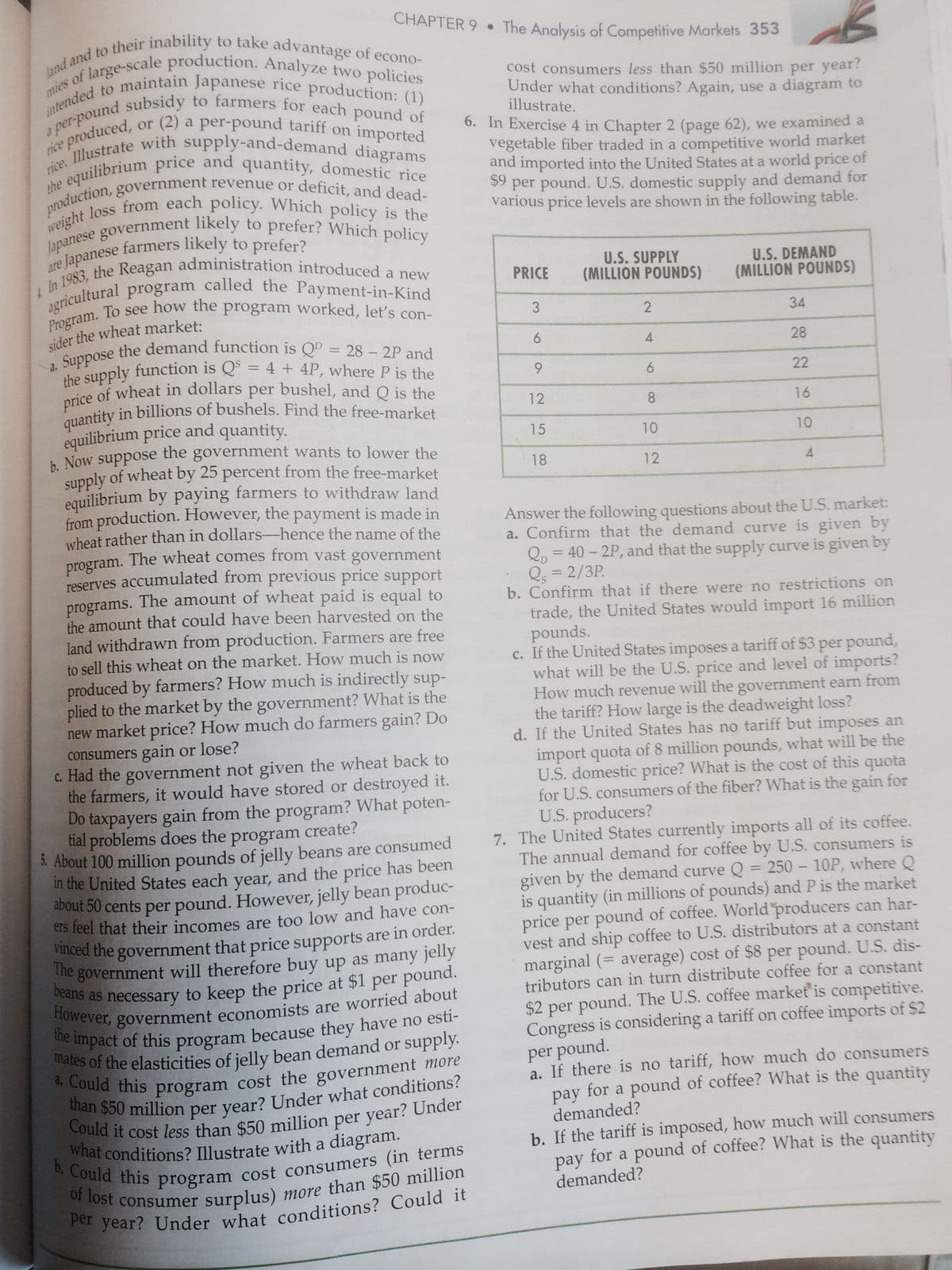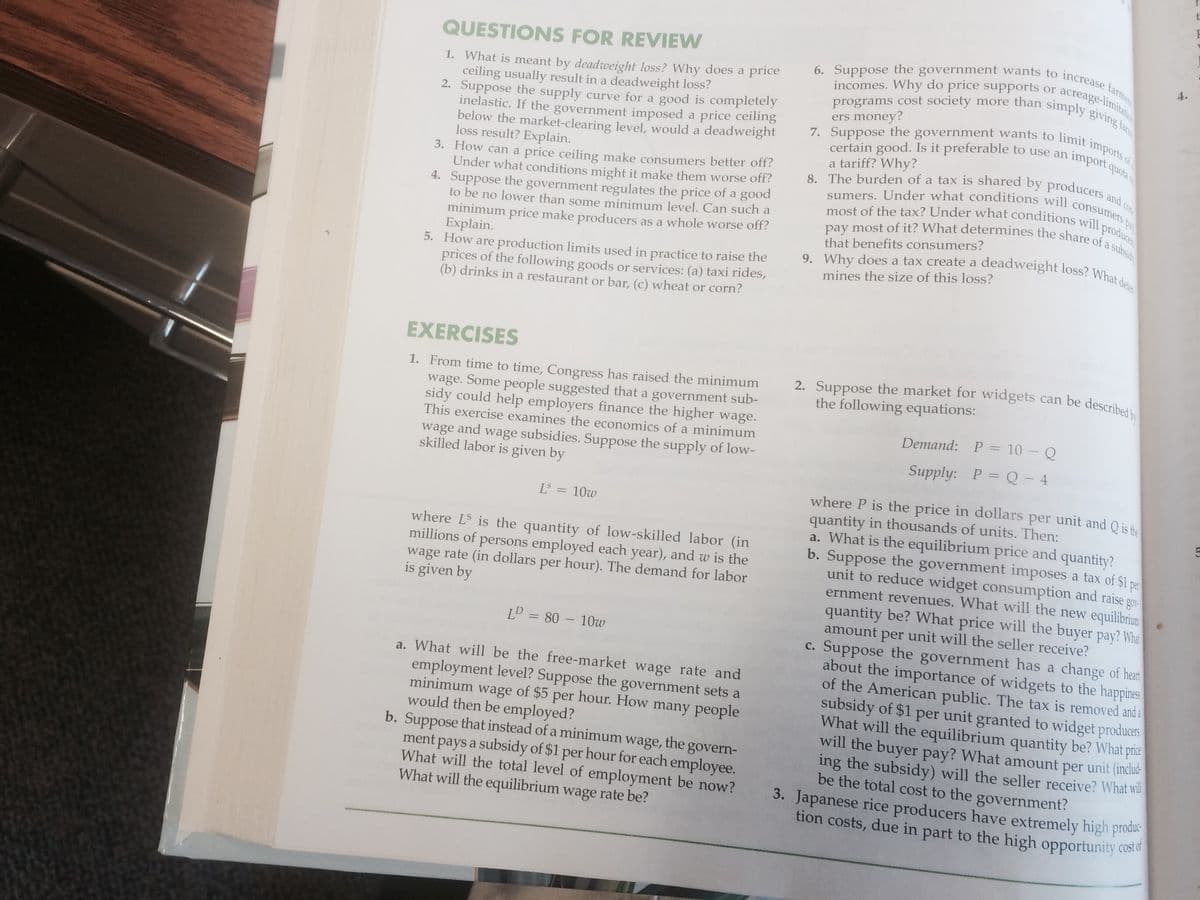Essentials of Economics (MindTap Course List)
8th Edition
ISBN:9781337091992
Author:N. Gregory Mankiw
Publisher:N. Gregory Mankiw
Chapter6: Supply, Demand And Government Policies
Section: Chapter Questions
Problem 7PA
Related questions
Question
Questions number 1, 2, 4 a and b. I do not understand?

Transcribed Image Text:the supply function is Q$ = 4 + 4P, where P is the
price of wheat in dollars per bushel, and Q is the
b. Could this program cost consumers (in terms
quantity in billions of bushels. Find the free-market
what conditions? Illustrate with a diagram.
beans as necessary to keep the price at $1 per pound.
a. Suppose the demand function is QD = 28 – 2P and
Program. To see how the program worked, let's con-
the equilibrium price and quantity, domestic rice
weight loss from each policy. Which policy is the
rice. Illustrate with supply-and-demand diagrams
a subsidy to farmers for each pound of
agricultural program called the Payment-in-Kind
Japanese government likely to prefer? Which policy
production, government revenue or deficit, and dead-
land and to their inability to take advantage of econo-
mies of large-scale production. Analyze two policies
intended to maintain Japanese rice production: (1)
In 1983, the Reagan administration introduced a new
CHAPTER 9 •
The Analysis of Competitive Markets 353
cost consumers less than $50 million per year?
Under what conditions? Again, use a diagram to
illustrate.
or (2) a per-pound tariff on imported
produced,
6. In Exercise 4 in Chapter 2 (page 62), we examined a
vegetable fiber traded in a competitive world market
and imported into the United States at a world price of
$9 per pound. U.S. domestic supply and demand for
various price levels are shown in the following table.
rice
farmers likely to prefer?
are Japanese
U.S. SUPPLY
(MILLION POUNDS)
U.S. DEMAND
(MILLION POUNDS)
PRICE
3
34
sider the wheat market:
6.
28
9.
6.
22
12
8.
16
equilibrium price and quantity.
h Now suppose the government wants to lower the
supply of wheat by 25 percent from the free-market
equilibrium by paying farmers to withdraw land
from production. However, the payment is made in
vwheat rather than in dollars-hence the name of the
15
10
10
18
12
4.
Answer the following questions about the U.S. market:
a. Confirm that the demand curve is given by
Qp = 40 – 2P, and that the supply curve is given by
Qs = 2/3P.
b. Confirm that if there were no restrictions on
The wheat comes from vast government
program.
reserves accumulated from previous price support
programs. The amount of wheat paid is equal to
the amount that could have been harvested on the
land withdrawn from production. Farmers are free
to sell this wheat on the market. How much is now
produced by farmers? How much is indirectly sup-
plied to the market by the government? What is the
new market price? How much do farmers gain? Do
%3D
trade, the United States would import 16 million
pounds.
c. If the United States imposes a tariff of $3 per pound,
what will be the U.S. price and level of imports?
How much revenue will the government earn from
the tariff? How large is the deadweight loss?
d. If the United States has no tariff but imposes an
import quota of 8 million pounds, what will be the
U.S. domestic price? What is the cost of this quota
for U.S. consumers of the fiber? What is the gain for
U.S. producers?
7. The United States currently imports all of its coffee.
The annual demand for coffee by U.S. consumers is
given by the demand curve Q = 250 – 10P, where Q
is quantity (in millions of pounds) and P is the market
price per pound of coffee. World producers can har-
vest and ship coffee to U.S. distributors at a constant
marginal (= average) cost of $8 per pound. U.S. dis-
tributors can in turn distribute coffee for a constant
$2 per pound. The U.S. coffee market is competitive.
Congress is considering a tariff on coffee imports of $2
consumers gain or lose?
C. Had the government not given the wheat back to
the farmers, it would have stored or destroyed it.
Do taxpayers gain from the program? What poten-
tial problems does the
3. About 100 million pounds of jelly beans are consumed
in the United States each year, and the price has been
about 50 cents per pound. However, jelly bean produc-
ers feel that their incomes are too low and have con-
program
create?
iced the government that price supports are in order.
he government will therefore buy up as many jelly
per pound.
a. If there is no tariff, how much do consumers
pay for a pound of coffee? What is the quantity
demanded?
b. If the tariff is imposed, how much will consumers
pay for a pound of coffee? What is the quantity
of lost
consumer surplus)
more than $50 million
demanded?

Transcribed Image Text:QUESTIONS FOR REVIEW
4.
incomes. Why do price supports or acreage-limitati
programs cost society more than simply giving fam
certain good. Is it preferable to use an import quota
pay most of it? What determines the share of a subsid
6. Suppose the government wants to increase farme
8. The burden of a tax is shared by producers and con
9. Why does a tax create a deadweight loss? What dete
2. Suppose the market for widgets can be described b
1. What is meant by deadweight loss? Why does a price
ceiling usually result in a deadweight loss?
2. Suppose the supply curve for a good is completely
inelastic. If the government imposed a price ceiling
below the market-clearing level, would a deadweight
loss result? Explain.
3. How can a price ceiling make consumers better off?
Under what conditions might it make them worse off?
4. Suppose the government regulates the price of a good
to be no lower than some minimum level. Can such a
minimum price make producers as a whole worse off?
Explain.
5. How are production limits used in practice to raise the
prices of the following goods or services: (a) taxi rides,
(b) drinks in a restaurant or bar, (c) wheat or corn?
ers money?
7. Suppose the government wants to limit
imports of
a tariff? Why?
consumers
sumers. Under what conditions will
produce
most of the tax? Under what conditions will
that benefits consumers?
mines the size of this loss?
EXERCISES
1. From time to time, Congress has raised the minimum
wage. Some people suggested that a government sub-
sidy could help employers finance the higher wage.
This exercise examines the economics of a minimum
the following equations:
Demand:
P = 10 - Q
wage and wage subsidies. Suppose the supply of low-
skilled labor is given by
Supply: P =
Q- 4
where P is the price in dollars per unit and Q is the
quantity in thousands of units. Then:
a. What is the equilibrium price and quantity?
b. Suppose the government imposes a tax of $1 pa
unit to reduce widget consumption and raise gov-
ernment revenues. What will the new equilibrium
quantity be? What price will the buyer pay? Wha
amount per unit will the seller receive?
Suppose the government has a change of heart
about the importance of widgets to the happines
of the American public. The tax is removed and a
subsidy of $1 per unit granted to widget producers
What will the equilibrium quantity be? What price
will the buyer pay? What amount per unit (includ-
ing the subsidy) will the seller receive? What wil
be the total cost to the government?
3. Japanese rice producers have extremely high produc
tion costs, due in part to the high opportunity coste
L = 10w
where LS is the quantity of low-skilled labor (in
millions of persons employed each year), and w is the
wage rate (in dollars per hour). The demand for labor
is given by
LD
= 80 - 10w
с.
a. What will be the free-market wage rate and
employment level? Suppose the government sets a
minimum wage of $5
would then be employed?
b. Suppose that instead of a minimum wage, the govern-
ment pays a subsidy of $1 per hour for each employee.
What will the total level of employment be now?
What will the equilibrium wage rate be?
per
hour. How many people
Expert Solution
This question has been solved!
Explore an expertly crafted, step-by-step solution for a thorough understanding of key concepts.
This is a popular solution!
Trending now
This is a popular solution!
Step by step
Solved in 2 steps with 1 images

Knowledge Booster
Learn more about
Need a deep-dive on the concept behind this application? Look no further. Learn more about this topic, economics and related others by exploring similar questions and additional content below.Recommended textbooks for you

Essentials of Economics (MindTap Course List)
Economics
ISBN:
9781337091992
Author:
N. Gregory Mankiw
Publisher:
Cengage Learning

Microeconomics: Principles & Policy
Economics
ISBN:
9781337794992
Author:
William J. Baumol, Alan S. Blinder, John L. Solow
Publisher:
Cengage Learning

Exploring Economics
Economics
ISBN:
9781544336329
Author:
Robert L. Sexton
Publisher:
SAGE Publications, Inc

Essentials of Economics (MindTap Course List)
Economics
ISBN:
9781337091992
Author:
N. Gregory Mankiw
Publisher:
Cengage Learning

Microeconomics: Principles & Policy
Economics
ISBN:
9781337794992
Author:
William J. Baumol, Alan S. Blinder, John L. Solow
Publisher:
Cengage Learning

Exploring Economics
Economics
ISBN:
9781544336329
Author:
Robert L. Sexton
Publisher:
SAGE Publications, Inc

Economics: Private and Public Choice (MindTap Cou…
Economics
ISBN:
9781305506725
Author:
James D. Gwartney, Richard L. Stroup, Russell S. Sobel, David A. Macpherson
Publisher:
Cengage Learning

Macroeconomics: Private and Public Choice (MindTa…
Economics
ISBN:
9781305506756
Author:
James D. Gwartney, Richard L. Stroup, Russell S. Sobel, David A. Macpherson
Publisher:
Cengage Learning

Microeconomics: Private and Public Choice (MindTa…
Economics
ISBN:
9781305506893
Author:
James D. Gwartney, Richard L. Stroup, Russell S. Sobel, David A. Macpherson
Publisher:
Cengage Learning